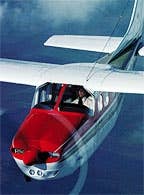
When to move up; and how far
I bought a new Cardinal RG in 1976 and, while I liked the airplane, my mission changed. I had been living in Little Rock, Arkansas, working for Flying, and the general aviation business of that day was concentrated in the middle of the country. My average jaunt was about 300 nm. In 1977, I moved to New York and suddenly all those easy-to-reach places from Little Rock were many miles farther away.
That sent me looking for something faster. I had always wanted a 210, available then, in 1979, with boots and radar. I decided that I wanted either a normally aspirated or pressurized airplane. The turbocharged model had little appeal because I wasn't going to use oxygen on a regular basis.
Several pencils and a couple of legal pads were expended making the decision. I still have the papers, and reviewing them is fun. The 210 made more sense, but I wanted the P210. It's 100 percent about want and zero about need, so a new P210 was what I selected.
The airplane, with deicing and weather radar, high flying ability without oxygen and better comfort and performance, to say nothing of the leather interior, looked like it would be a giant leap from a Cardinal RG.
I knew this wouldn't come free, and my original calculation was that the 210 would run 60 percent more per hour to fly than the Cardinal, based simply on the fact that it would burn 60 percent more fuel. That was a little naive because of the more complex systems of the P210 and the greater monetary demands of a turbocharged engine.
There was also the purchase price. Sale of the Cardinal RG brought only enough money for a modest down payment on the P210.
So how has the airplane done on living up to its promises? Very well is the answer, though, because it was a new airplane and a relatively new concept, this pressurized single really had growing pains. All the systems in the airplane gave problems in the first years, and the airworthiness directives seemed to arrive in blizzards of paperwork. A lot of people had trouble with the engines, too, and they were (and remain) the most temperamental and hard to manage turbocharged engines on the planet. All these years and hours later, though, the airplane is more reliable than when it was new.
The performance of the airplane lived up to most of the claims. It wasn't promised to be a strong climber, and it isn't. I still have the 1979 brochure on the airplane and it claims 200 knots cruise at 20,000 feet. That was a false promise because the superlative number in the current POH is 189 at that altitude. I'd have to lean forward in the seat to make it go that fast, too.
Where the airplane really delivers is in comfort. The cabin is quiet because of the heavier structure for the pressurization, and the seats are supremely comfortable. The ride in turbulence is quite good, too. The high flying ability makes a lot of trips more serene, and all the avionics and other accessories I have lavished on it over the years have increased its IQ manyfold.
It took a while to learn how to maximize the performance against conditions. Flying high only when there is a solid benefit was an acquired skill. In the beginning it was tempting to go for the Flight Levels on every flight. No more.
When westbound in a big wind, the P210 can be flown low just like a regular 210, though it is substantially slower-at least 10 or 15 knots. It's self-kidding to say that there are not performance give-backs in having boots and a radar pod and pressurization, and in later years, a virtual forest of antennas. The fastest 210 will always be the most basic.
My original cost estimate was pretty far off. I'd say that the airplane costs a bit more than twice as much to fly as a simpler 200-hp retractable. The increase in annual groundspeed-probably on the order of 15 to 18 knots-is modest. On the other hand, a 10 to 15 percent speed increase for a 100 percent cost increase is about how airplanes work.
The next step? I came close to making a deal on a pressurized Baron in the early to mid '80s. All the pencils and pads that I could find wouldn't make that fly, though. For now, my next logical airplane would be a single turboprop, with the Piper Meridian the next step on the ladder from an affordability standpoint. Still, the sale of the P210 would result in a smaller percentage of the down payment on a Meridian than the 177RG did for the P210.
Winning the lottery would make me look at the TBM 700 and Pilatus PC-12. An executive Cessna Caravan would be fun but, alas, no pressurization, and leaving that behind would be a genuine step back in time. And why take a next step? My airplane is only 23 years old and has but 8,000 hours on it. There's a lot of strut left in that puppy.

Sign-up for newsletters & special offers!
Get the latest FLYING stories & special offers delivered directly to your inbox






